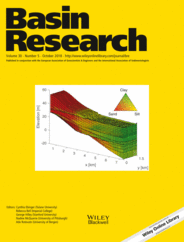
Full text loading...
Constraining the thermal, burial and uplift/exhumation history of sedimentary basins is crucial in the understanding of upper crustal strain evolution and also has implications for understanding the nature and timing of hydrocarbon maturation and migration. In this study, we use Vitrinite Reflectance (VR) data to elucidate the paleo‐physiography and thermal history of an inverted basin in the foreland of the Atlasic orogeny in Northern Tunisia. In doing so, it is the primary aim of this study to demonstrate how VR techniques may be applied to unravel basin subsidence/uplift history of structural domains and provide valuable insights into the kinematic evolution of sedimentary basins. VR measurements of both the onshore Pelagian Platform and the Tunisian Furrow in Northern Tunisia are used to impose constraints on the deformation history of a long‐lived structural feature in the studied region, namely the Zaghouan Fault. Previous work has shown that this fault was active as an extensional structure in Lower Jurassic to Aptian times, before subsequently being inverted during the Late Cretaceous Eocene Atlas I tectonic event and Upper Miocene Atlas II tectonic event. Quantifying and constraining this latter inversion stage, and shedding light on the roles of structural inheritance and the basin thermal history, are secondary aims of this study. The results of this study show that the Atlas II WNW‐ESE compressive event deformed both the Pelagian Platform and the Tunisian Furrow during Tortonian‐Messinian times. Maximum burial depth for the Pelagian Platform was reached during the Middle to Upper Miocene, i.e. prior to the Atlas II folding event. VR measurements indicate that the Cretaceous to Ypresian section of the Pelagian Platform was buried to a maximum burial depth of ~3 km, using a geothermal gradient of 30°C/km. Cretaceous rock samples VR values show that the hanging wall of the Zaghouan Fault was buried to a maximum depth of <2 km. This suggests that a vertical km‐scale throw along the Zaghouan Fault pre‐dated the Atlas II shortening, and also proves that the fault controlled the subsidence of the Pelagian Platform during the Oligo‐Miocene. Mean exhumation rates of the Pelagian Platform throughout the Messinian to Quaternary were in the order of 0.3 mm/year. However, when the additional effect of Tortonian‐Messinian folding is accounted for, exhumation rates could have reached 0.6–0.7 mm/year.

Article metrics loading...

Full text loading...
References


Data & Media loading...

